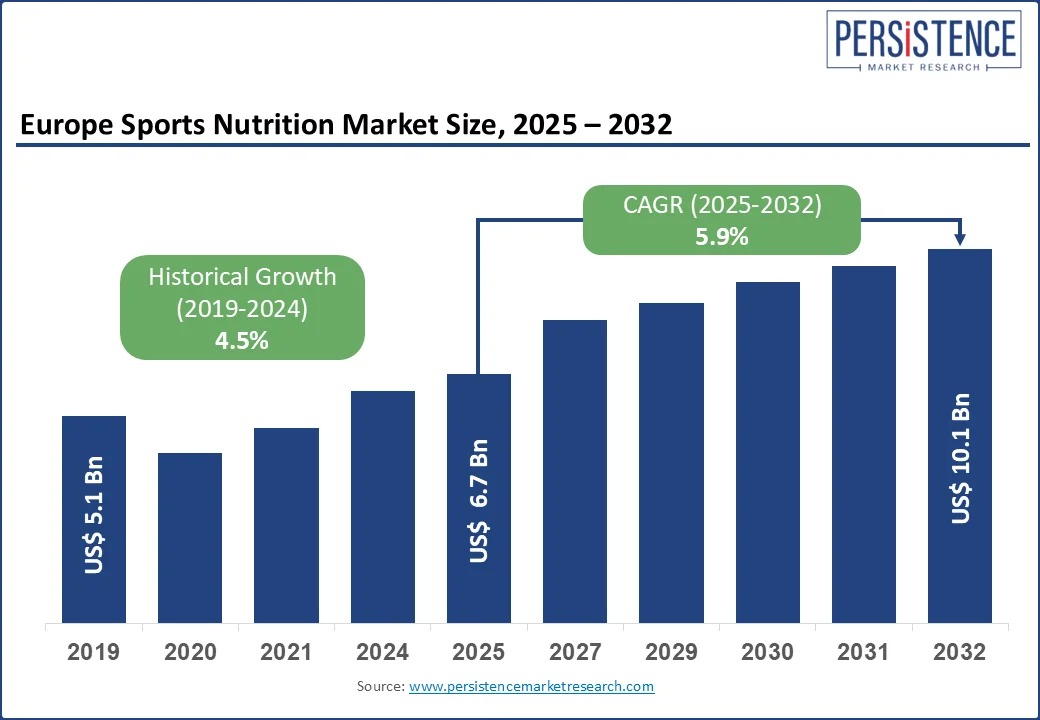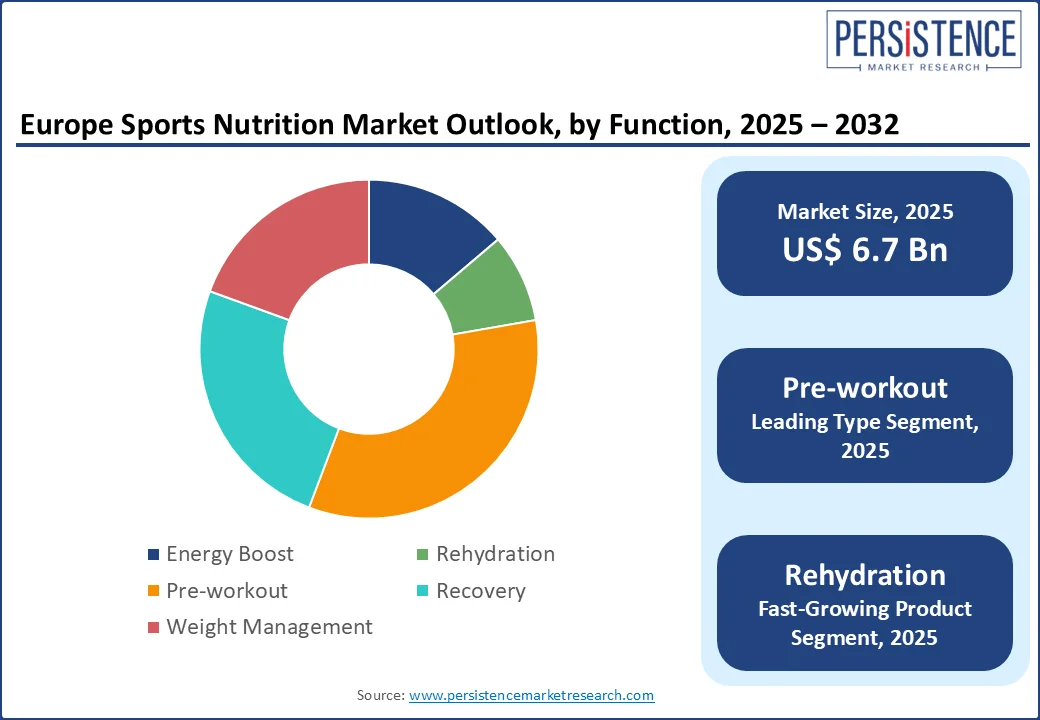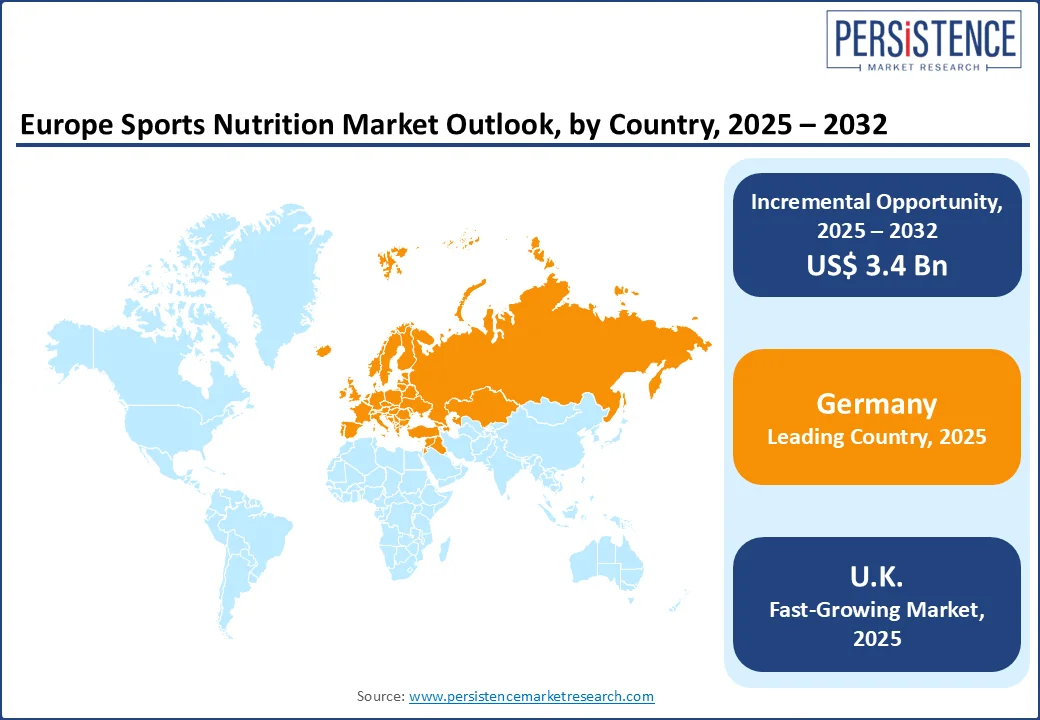ID: PMRREP34896| 172 Pages | 6 Aug 2025 | Format: PDF, Excel, PPT* | Food and Beverages

Europe sports nutrition market size is likely to be valued at US$ 6.7 Bn in 2025 and is estimated to reach US$ 10.1 Bn in 2032, growing at a CAGR of 5.9% during the forecast period 2025 - 2032. The sports nutrition market growth in Europe is driven by the surging demand for plant-based, clean-label supplements, rising participation in fitness and organized sports, and the rapid expansion of e-commerce channels across Germany and the U.K. According to the European Commission, in 2019, the percentage of overweight adults in the European Union (EU) ranged from 37% in Italy to 58% in Croatia among women, and from 53% in France to 73% in Croatia among men. These numbers are predicted to rise with the increasing adoption of sedentary lifestyles and surging consumption of junk food. Hence, sports nutrition demand is projected to rise among those living with obesity to maintain their health.

Key Industry Highlights:
|
Market Attribute |
Key Insights |
|
Europe Sports Nutrition Market Size (2025E) |
US$ 6.7 Bn |
|
Market Value Forecast (2032F) |
US$ 10.1 Bn |
|
Projected Growth (CAGR 2025 to 2032) |
5.9% |
|
Historical Market Growth (CAGR 2019 to 2024) |
4.5% |
As the European population increasingly prioritizes healthy living, there is a rising demand for sports nutrition products that aid in achieving fitness goals and enhancing wellness. This proactive health approach attracts both fitness enthusiasts and individuals seeking better nutrition. Products that promote muscle recovery and energy enhancement, particularly protein supplements, have become staples in various diets. These are set to gain traction due to their high effectiveness in muscle maintenance regardless of athletic involvement.
The popularity of plant-based and organic sports nutrition reflects consumers' growing preference for clean, sustainably sourced ingredients. Public health campaigns and social media influences significantly impact consumer education regarding balanced nutrition and the importance of protein intake. Initiatives by health organizations are set to promote healthy habits, while fitness influencers are likely to advocate for sports nutrition products on platforms such as Instagram and YouTube. This rising health awareness is projected to continue driving demand, making sports nutrition a key growth area in Europe’s health and wellness industry.
Several brands are now emphasizing organic ingredients, plant-based proteins, and recyclable or biodegradable packaging to meet this demand. For instance, plant-based protein products are gaining traction due to the growing number of vegan, vegetarian, and flexitarian consumers, especially in countries such as Germany and the U.K. This shift aligns with broader environmental values, where consumers are concerned about sourcing and the sustainability of raw materials.
Well-established companies are making significant strides in the vegan sports nutrition market by broadening their product lines. They include both pre- and post-workout options alongside their traditional protein powders. Innovations in a diverse range of plant-based proteins have also led to the development of high-protein bars in enticing flavors.
For instance, in February 2024, Trek, based in the U.K., joined hands with Biscoff to introduce the Trek Power Biscoff protein bar. It is considered the company’s only 100% real Biscoff protein bar. The bar is coated in vegan chocolate, includes 15g of plant-based soya protein, and is filled with a layer of Biscoff spread. The development highlights the industry's commitment to catering to the growing demand for delicious yet nutritious vegan alternatives in sports nutrition.
Premium pricing in Europe sports nutrition market acts as a significant restraint on accessibility for certain consumers. High costs associated with premium products limits the purchasing power of individuals. It is particularly evident in the lower-income consumers who are less likely to prioritize spending on fitness.
Various brands justify their high price points by emphasizing superior ingredients, extensive research, or endorsements from renowned athletes. The aforementioned strategies are projected to create challenges for new market entrants, as they struggle to compete against established brands such as USN and Optimum Nutrition. These brands have successfully cultivated strong consumer loyalty through aggressive marketing and sponsorship of sporting events. As a result, modern consumers often seek alternatives outside traditional sports nutrition.
Millennials are set to favor natural or organic food items that are perceived as healthier, even if they are more expensive. While premium pricing can signify quality and exclusivity, it simultaneously restricts market penetration and limits access to a broad audience. Brands may need to reconsider their pricing strategies to attract a more diverse consumer base. This is ultimately projected to help balance quality with affordability to enhance accessibility in Europe.
Strategic alliances with athletes and sports organizations are set to present significant opportunities for the Europe sports nutrition market growth. These partnerships are expected to enhance brand visibility, credibility, and product influence. Collaborations with elite athletes and sports celebrities are further anticipated to amplify the perceived efficacy of nutritional products, linking them directly to athletic performance.
For instance, Maurten, a sports nutrition brand based in Sweden, became the official sponsor of Bermuda’s Olympic team for the 2024 Paris Summer Olympics. This emphasized the brand’s commitment to providing advanced nutritional support to elite athletes on a global stage. It also helped reinforce Maurten’s reputation as a trusted sports nutrition provider, appealing to performance-focused consumers across Europe and other regions.
Sports organizations and event companies are anticipated to offer new platforms for brands to showcase novel products, thereby increasing awareness among audiences. Additionally, partnerships with governing bodies and sports teams are set to help nutrition companies navigate the competitive landscape. These partnerships are projected to help them align with recognizable authorities to build consumer trust and broaden their reach across Europe’s diverse sports nutrition industry.
Based on function, the pre-workout segment is anticipated to generate around 33.5% of Europe sports nutrition market share in 2025. Modern consumers, recognizing the benefits of pre-workout supplements, are adding these products to their fitness regimens to enhance performance.
Designed to deliver a quick energy boost and reduce fatigue, pre-workout supplements commonly include ingredients such as caffeine, beta-alanine, and nitric oxide boosters. These supplements are especially favored by gym-goers and athletes in the need of consistent energy and mental focus, aligning well with Europe’s strong culture of fitness.
Pre-workout supplements are also gaining popularity due to their ease of use as well as availability in various forms such as powders, liquids, and ready-to-drink options. Their accessibility has grown with the rise of e-commerce and in-gym sales, reaching a wider audience.
Modern consumers prioritize scientifically supported, safe, and effective products. It is driving brands to emphasize ingredient transparency and quality by highlighting the presence of clinically tested components. This surging focus resonates with health-conscious buyers who seek trustworthy and high-performance products.
Online retail is projected to drive substantial growth in Europe sports nutrition industry, due to easy access to a wide range of products from protein supplements to specialized items such as vegan protein powders and gluten-free energy bars.
Rapid shift to e-commerce has also democratized the market, allowing both amateur and professional athletes to easily incorporate these products into their routines. Consumers benefit from the convenience of browsing, comparing, and purchasing sports nutrition products online. This is further supported by digital marketplaces and innovative payment options such as ‘buy now, pay later.’ For instance, Accordingg to the International Trade Administration, the U.K. ranks as the world’s third-largest e-commerce market after China and the U.S. Consumer e-commerce comprises 36.3% of the total U.K. retail market, and revenues are set to reach US$ 285.6 Bn by 2025.
The robust e-commerce infrastructure supports sports nutrition brands in leveraging targeted digital marketing, data analytics, and consumer insights. These strategies are projected to help personalize experiences, foster brand loyalty, and cater to niche demands, setting a trend for continued online market expansion.

The demand for natural health products is anticipated to rise significantly in Germany during the forecast period. Increasing health consciousness and commitment to active lifestyles, including fitness, weight management, and wellness, is anticipated to boost growth.
The established fitness industry in Germany, comprising several gyms, sports clubs, and wellness facilities, fosters a vibrant community of fitness enthusiasts and athletes. They are set to frequently consume sports supplements, protein products, and other performance enhancers.
The country’s strict regulatory framework on food quality and safety also builds consumer trust by ensuring sports nutrition products meet rigorous standards. Additionally, Germany’s central location within Europe and its efficient distribution networks enable seamless production and supply of sports nutrition products. Together, these factors solidify the country’s prominent role in the regional market.
The U.K. sports nutrition market is evolving rapidly, driven by rising health awareness and increased participation in organized sports and fitness activities. According to the Sport England, over 61% of adults in the U.K. engage in physical activity weekly, with notable growth in gym memberships and recreational sports such as cycling and running. The country's visibility in global events such as the Olympics, Commonwealth Games, and UEFA tournaments has spurred interest in performance-enhancing nutrition.
The government’s initiatives under UK Active and the School Sport and Activity Action Plan are further reinforcing the demand for functional sports nutrition products among both youth and adults. There is a marked shift toward clean-label, plant-based formulations and personalized nutrition options, with consumers seeking products that support endurance, recovery, and hydration, especially in urban and digitally connected demographics.

Europe sports nutrition industry is highly competitive, driven by established brands and new entrants alike. Key players such as Glanbia (Optimum Nutrition), USN, and MyProtein dominate with strong brand recognition and diverse product offerings across categories such as protein supplements, pre-workouts, and recovery products. These companies leverage aggressive marketing strategies, athlete endorsements, and event sponsorships to maintain loyalty and visibility.
Small-scale brands and start-ups, on the other hand, are entering the market by focusing on niche segments such as plant-based or allergen-free products to cater to specific consumer needs. The shift to e-commerce also intensifies competition, allowing both large and small brands to reach broad audiences through digital platforms and personalized marketing.
Europe sports nutrition market is projected to be valued at US$ 6.7 Bn in 2025.
The rising emphasis on healthy living among modern individuals is driving Europe sports nutrition market.
Europe sports nutrition market is poised to witness a CAGR of 5.9% between 2025 and 2032.
Collaboration with popular athletes and sports teams represents a key market opportunity for brands to enhance their reach and credibility.
Major players in Europe sports nutrition market include Nestlé S.A., Glanbia PLC, THG Nutrition Limited Inc., The Quality Group, Amway, and Herbalife International, Inc.
|
Report Attribute |
Details |
|
Historical Data/Actuals |
2019 - 2024 |
|
Forecast Period |
2025 - 2032 |
|
Units |
Value: US$ Bn |
|
Country wise Coverage |
|
|
Segment Coverage |
|
|
Competitive Analysis |
|
|
Report Highlights |
|
|
Customization and Pricing |
Available upon request |
By Function
By Form
By Flavor
By Micronutrients
By Sales Channel
By Country
Delivery Timelines
For more information on this report and its delivery timelines please get in touch with our sales team.
About Author